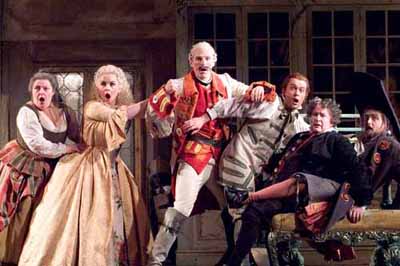Seen and Heard Opera Review
Rossini, The Barber of Seville
Soloists, Chorus & Orchestra of English National Opera/Dominic
Wheeler, Coliseum, February 16th, 2005 (CC)
Budapest-trained Dominic Wheeler, who conducted the final performance
of Siegfried in November, is a conductor I want to see
and hear more of. His handling of the overture to Rossini’s
Barber of Seville had an almost Mozartian swiftness about
it (although, puzzlingly, fortes seemed more like mezzo-fortes
from the stalls) and certainly prepared the audience for the ensuing
tomfoolery. The ENO orchestra were at its considerable best (a
sure sign of its respect for Wheeler), reacting to dramatic situations
with split-second accuracy.

Jonathan Miller’s fertile imagination seems particularly
inspired by the lighter side of Seville life (this ninth revival
of the 1987 original is by William Relton). Thus, the opening
group of actors and musicians who accompany the Count is straight
from the Commedia dell’arte (this applies to gestures –
almost Coco the Clown – as well as costumes).
Charles Workman is the Count Almaviva (a role he has undertaken
here before). Confident and vocally strong, if not holding himself
with an aura of true nobility, this Count is more than adequate.
Faint praise? Perhaps, but all becomes plain (and defensible)
when Andrew Shore takes to the stage as Rosina’s guardian,
Doctor Bartolo, whose full yet amazingly agile voice is a joy,
and whose stage presence is second to none. Shore, a great character
actor, is really the true star of this Barber. Throughout, his
timing in recitative was beyond criticism.
All becomes clearer in the specifics of casting when one realises
that Shore and Workman work so well together vocally. The cast
seems handpicked so that any one given combination will see characters
sparking off one another. And it is this spark that Rossini is
all about. Of course, this particular Rossini is in one sense
‘about’ the Barber, here taken by Mark Stone (last
seen, and admired, by this reviewer last September at ENO in Don
Giovanni). If all was not entirely happy between soloist and
orchestra in the ‘Largo al factotum,’ there is no
denying Stone’s ability to project a character’s cocky
confidence.
Rosina is, of course, vital. Company Principal Alison Roddy is
equipped with the perfect, girlish voice for the part, and her
instrument is indeed as agile as she is coquettish. ‘Una
voce poco fa’ was the almost perfect example of this (although
she started a little shrill and tremulous). Robert Pomakov’s
Don Basilio is entertaining, the comic timing in the Act II ‘confrontations’
with Figaro pure delight. It was in this second act that one became
fully aware of how expertly Rossini crafts his farce. Mary Lloyd-Davies
certainly deserves a mention for her humorous portrayal of Bartolo’s
housekeeper, Berta, thoroughly enjoying the chances Rossini gives
her to shine.
Ensembles remained not only superb throughout but evidence in
sound of the excellence of casting. Apart from some creaking scenery
between the two parts of Act I, the minutiae of staging and lighting
enhance the stage antics. This is a Barber that sparkles
like champagne, the entire company working towards a magnificent
expression of Rossini’s genius. Do go and see it.
Colin Clarke
Photo © Robert Workman, Rossini’s Barber of Seville,
ENO, February 2005

